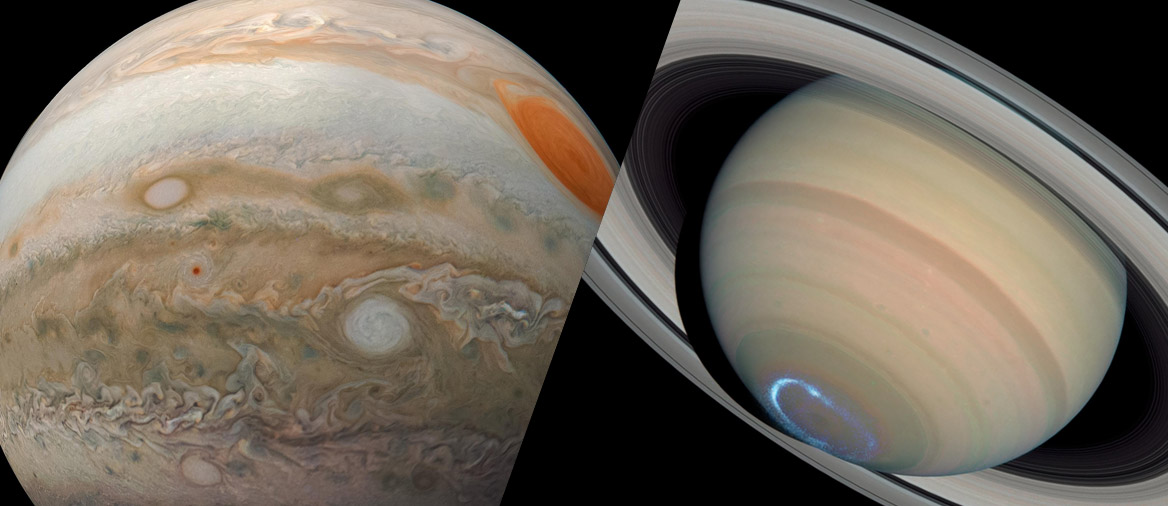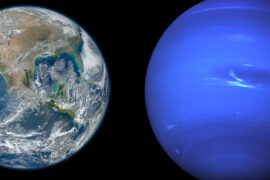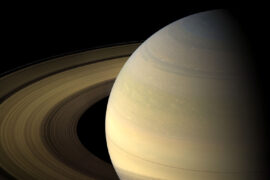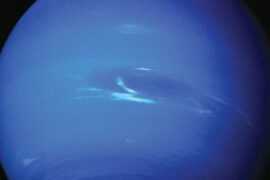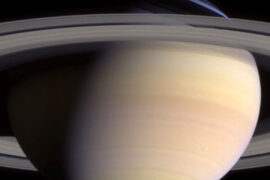Jupiter and Saturn are the two biggest planets in the Solar system. And they happen to be neighbors to each other. It is no coincidence that they are called gas giants. The two of them account for more than 92% of all the mass of the planets in the Solar system.
Both of these planets share many similarities like their composition, fast rotation speed, rough weather, plenty of moons, and even the fact that both of them have rings around them (although Saturn clearly wins in that regard). However, that doesn’t mean that each of them doesn’t have unique features that make them different.
As a matter of fact, they are not even as close to each other as you might think. Jupiter and Saturn are, on average, 646 million kilometers (402 million miles) apart from each other. For comparison, Jupiter is on average 629 million kilometers (391 million miles). That means that Jupiter is actually closer to Earth than Saturn! Cool, huh?
In this article, we’ll take a look at the differences and similarities between Jupiter and Saturn so we can learn more about these two intriguing giants of the Solar system.
Jupiter vs Saturn comparison
The following table shows the differences between both planets’ basic information. It is important to note that many of these numbers are averages or estimates. For example, the distance to the Sun is given as an average because the orbit of the planets makes the distance between them and the Sun change throughout the year.
| Jupiter | Saturn | |
|---|---|---|
| Position in the Solar system | 5 | 6 |
| Distance from the Sun (avg) | 741 million km | 1,460 million km (1.46 billion km) |
| Radius | 69,900 km | 58,232 km |
| Mass | 1.9 × 1027 kg | 5.6834×1026 |
| Rotation period (1 day) | 10 hours | 10.5 hours |
| Rotation speed | 45,000 km/h | 9.87 km/s |
| Orbit period (1 year) | 11.85 years | 29.4 years (10,759 days) |
| Orbital speed | 13.07 km/s | 9.68 km/s |
| Average temperature | −110 °C | -140 °C |
| Surface pressure | 200 – 600 kPa | 140 kPa |
| Surface gravity | 24.79 m/s2 | 10.44 m/s2 |
| Density | 1.33 g/cm3 | 0.687 g/cm3 |
| Escape Velocity | 59.5 km/s | 35.5 km/s |
| Albedo | 0.5 | 0.342 |
| Satellites (Moons) | 95 | 145 |
| Core | rock, metal, ice | rock |
| Atmosphere | 89% H, 10% He, 0.3% CH4, traces of others | 75% H, 25% He |
Jupiter vs Saturn size comparison
Jupiter and Saturn are the two biggest planets in the Solar system. Jupiter is slightly bigger with an approximate radius of 69,900 km (43,433 miles) versus 58,232 km (36,183 miles) of Jupiter. That is an approximate difference of 17%.
However, in volume that difference increases. You could fit approximately two planets the size of Saturn into Jupiter.
In terms of mass, Jupiter is slightly more dense than Saturn. Jupiter has approximately 3.3 times the mass of Saturn.
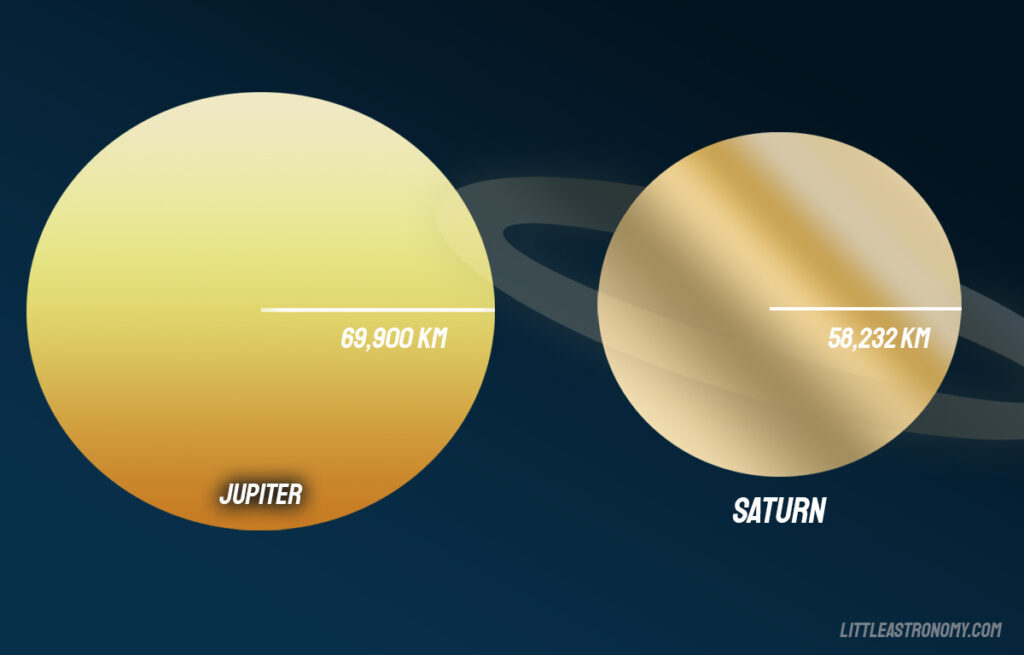
Jupiter and Saturn similarities
- Both planets are in the Solar system
- Both planets orbit the Sun
- Both planets are more or less the same age. They both formed approximately 4.5 billion years ago
- Both planets are spherical
- Both planets are mostly made up of gas and are considered “gas giants”
- Neither planet has a solid surface. If you were to “fall” into one of them, you would sink until you reached their core (assuming you could survive the extreme heat and pressure)
- Both planets are located beyond the asteroid belt
- Jupiter and Saturn rotate in the same direction (counter-clockwise)
- The elements with the highest concentration in both planets are hydrogen and helium
- Both planets rotate extremely fast. They are the two planets that rotate the fastest in the Solar system.
- Jupiter and Saturn are the two least dense planets in the Solar system
- Despite that, they are also the two planets with the highest masses
- They both have a large number of natural satellites (moons)
- Both planets have fast winds and storms
- Both planets are visible to the naked eye and were known by ancient civilizations.
- Jupiter and Saturn are named after Roman deities. Jupiter after the god of thunder, and Saturn after the god of agriculture.
- Both planets are outside the habitable zone of the Solar system
Jupiter and Saturn differences
- Jupiter’s diameter is 17% larger than Saturn’s. That means you could fit Saturn 3.3 times into Jupiter
- Jupiter’s gravity is much stronger by almost 2.5 times
- Jupiter is almost at the same distance to the Sun as to Saturn despite the two planets being “neighbors”
- Saturn’s rings are much more prominent. So much so that they are easily visible from Earth with a home telescope. Jupiter’s rings are small and dim. They are not visible from Earth.
- Saturn has more moons (145) than Jupiter (95). New moons are still being found on both planets so this might change in the future.
- Jupiter’s magnetic field is stronger than Saturn’s
- Due to their difference in distance from the Sun, one year in Jupiter is 11.8 Earth years, while one Saturn year is almost 3 times longer at 29.4 years.
- Saturn’s color is mostly yellow with some white mixed in. Jupiter is a lot more colorful with stripes of orange, brown, red, and white.
- Saturn is colder than Jupiter. Its average temperature is -140°C (-220°F) while Jupiter’s is “just” -110°C (-166°F)
Summary
- Jupiter and Saturn are two of the planets in the Solar system that have most things in common in relation to each other.
- The similarities between Jupiter and Saturn include their large size, elemental composition, rough weather, and that they are both made up of gas.
- The differences between Jupiter and Saturn include their distance to the Sun, magnetic field, the size of their rings, and color.

